翻译导论 英文简介
- 格式:ppt
- 大小:398.00 KB
- 文档页数:16
![翻译学导论(JeremyMunday)[整理]](https://uimg.taocdn.com/1dd7ca3fcec789eb172ded630b1c59eef8c79abc.webp)
第一章翻译学的主要方面小结:翻译研究是一个相对较新的研究领域,近年来获得了迅猛发展。
翻译以前是作为语言学习的一种方法,或是比较文学、翻译工作坊和对比语言学课程的一部分。
这门新的学科在很大程度上应该归功于詹姆斯.霍姆斯,他在《翻译研究的名与实》一文中不但为该领域提供了一个名称,而且还规划了该学科的结构。
翻译理论研究、描述性翻译研究和应用翻译学是互相关联的,近年来都有发展,逐渐在翻译理论与翻译实践之间架起了一座桥梁。
1. 翻译实践历史悠久,翻译学却是一门新兴学科。
2. 翻译实践和翻译理论之间的割裂持续存在。
3. James S. Holmes的《翻译研究的名与实》(The name and nature of translation studies, 1988年才为人所知)被认为是翻译学的“成立宣言”4. 翻译可以指翻译研究领域、翻译产品(译本)或者翻译过程(产生译本的行为)5. 俄裔美国结构主义学家Roman Jakobson在《论翻译的语言学方面》提出三种翻译类型:语内翻译(intralingual),语际翻译(interlingual),符际翻译(intersemiotic)6. 翻译研究作为一个学术研究领域是最近50年的事,它被称为“翻译学translatology”多亏了James S. Holmes.7. 对翻译的探讨,从公元前1世纪的西塞罗、贺拉斯和公元4世纪的圣哲罗姆(《七十子希腊文本圣经》)就开始了,后者被翻译成拉丁文时所用的手法影响了其后的圣经翻译。
8. 18世纪晚期到20世纪60年代,语法-翻译教学法统治了中学语言学习(死记硬背外语的语法规则和结构),20世纪六七十年代,直接法或交际法兴起,语言学习摒弃对翻译的摒弃,翻译局限于高层次大学语言课程和专业译员培训。
9. 翻译也是对比分析(contrastive analysis)领域的一个研究方向。
10. 霍姆斯的“描述性翻译理论”探讨三个方面:翻译产品(已有译作,探讨特定时期、某种语言/文本类型的翻译),翻译功能(哪些书籍何时何地被翻译,何种影响),翻译过程(挖掘译者大脑中发生的事情)11. 翻译理论、描述性翻译研究和应用翻译学还是会互相影响的。
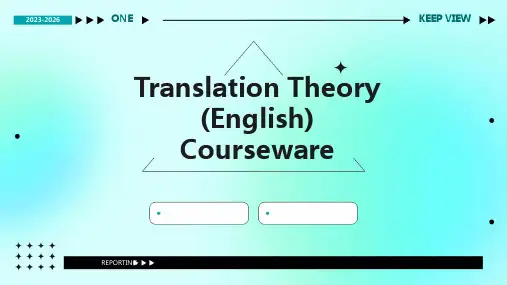
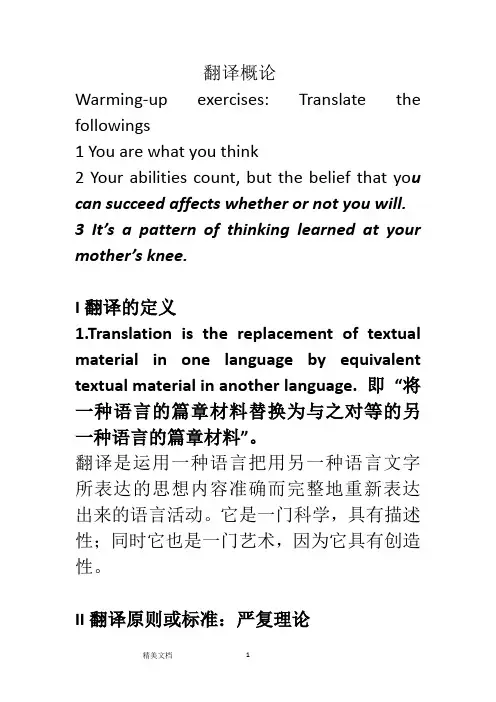
翻译概论Warming-up exercises: Translate the followings1 You are what you think2 Your abilities count, but the belief that yo u can succeed affects whether or not you will.3 It’s a pattern of thinking learned at your mother’s knee.I翻译的定义1.Translation is the replacement of textual material in one language by equivalent textual material in another language. 即“将一种语言的篇章材料替换为与之对等的另一种语言的篇章材料”。
翻译是运用一种语言把用另一种语言文字所表达的思想内容准确而完整地重新表达出来的语言活动。
它是一门科学,具有描述性;同时它也是一门艺术,因为它具有创造性。
II翻译原则或标准:严复理论1 信(truthfulness/faithfulness):忠实原文(对原文的思想不歪曲也不要任意增减;对原文的风格不随意改动,即粗糙的不译成高雅,口语体不译成书面体)2 达(expressiveness):语言通顺畅达(译文应该按照译语的语法和习惯来遣词造句;译文避免生搬硬套,应该通顺流畅)Eg . John can be relied on. He eats no fish and plays the game.约翰值得信赖。
他忠诚而正直(守规矩)。
3 雅(elegance):文字古雅/ 切(closeness)总之,做英译汉时,按中国人的说话思维方式,把内容用通俗的汉语顺畅地表达出来;反之亦然。
1. It therefore becomes more and more important that, if students are not to waste their opportunities, there will have to have much more detailed information about courses and more advice.2. People were afraid to leave their houses, for although the police had been ordered to stand by in case of emergency, they were justas confused and helpless as everybody else. 1. 因此,如果要使学生充分利用他们(上大学)的机会,就得为他们提供大量关于课程的更为详细的信息,作更多的指导。
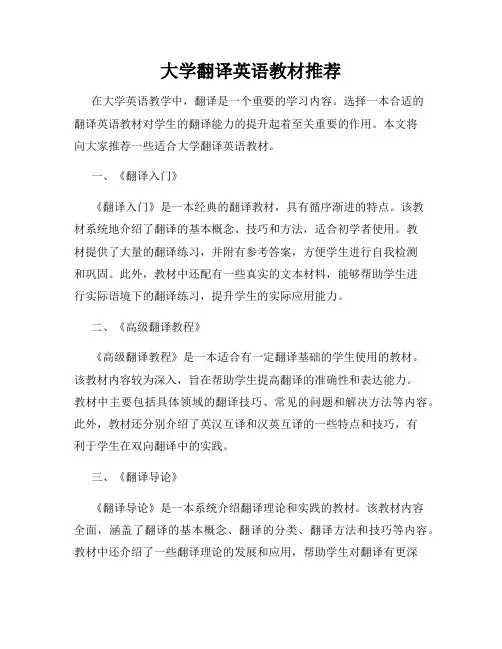
大学翻译英语教材推荐在大学英语教学中,翻译是一个重要的学习内容。
选择一本合适的翻译英语教材对学生的翻译能力的提升起着至关重要的作用。
本文将向大家推荐一些适合大学翻译英语教材。
一、《翻译入门》《翻译入门》是一本经典的翻译教材,具有循序渐进的特点。
该教材系统地介绍了翻译的基本概念、技巧和方法,适合初学者使用。
教材提供了大量的翻译练习,并附有参考答案,方便学生进行自我检测和巩固。
此外,教材中还配有一些真实的文本材料,能够帮助学生进行实际语境下的翻译练习,提升学生的实际应用能力。
二、《高级翻译教程》《高级翻译教程》是一本适合有一定翻译基础的学生使用的教材。
该教材内容较为深入,旨在帮助学生提高翻译的准确性和表达能力。
教材中主要包括具体领域的翻译技巧、常见的问题和解决方法等内容。
此外,教材还分别介绍了英汉互译和汉英互译的一些特点和技巧,有利于学生在双向翻译中的实践。
三、《翻译导论》《翻译导论》是一本系统介绍翻译理论和实践的教材。
该教材内容全面,涵盖了翻译的基本概念、翻译的分类、翻译方法和技巧等内容。
教材中还介绍了一些翻译理论的发展和应用,帮助学生对翻译有更深入的了解。
此外,教材还以实例为主,通过分析不同类型的翻译文本和具体案例,培养学生的翻译能力和应变能力。
四、《翻译教学与实践》《翻译教学与实践》是一本针对翻译教学的教材。
该教材将翻译教学与实际应用相结合,注重培养学生的实际操作能力。
教材中提供了大量的翻译实践案例和练习,使学生能够在实际运用中不断提升自己的翻译水平。
此外,教材还介绍了一些翻译教学的方法和策略,有助于教师有效地进行翻译教学。
五、《翻译与跨文化交际》《翻译与跨文化交际》是一本关注翻译与文化交流的教材。
该教材主要介绍了翻译与文化、翻译与语言的关系等内容,旨在帮助学生了解翻译在跨文化交际中的作用。
教材中还包含一些有关文化差异的案例和讨论,培养学生的跨文化意识和翻译能力。
通过该教材的学习,学生能够更好地理解不同文化间的差异,从而提高翻译质量和准确性。
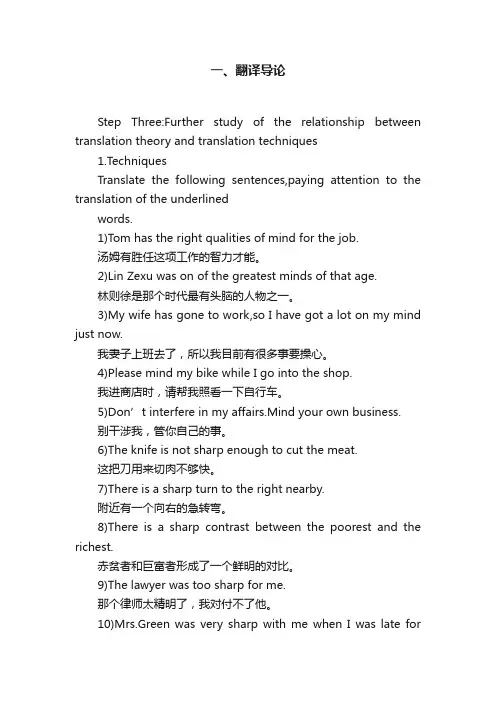
一、翻译导论Step Three:Further study of the relationship between translation theory and translation techniques1.TechniquesTranslate the following sentences,paying attention to the translation of the underlinedwords.1)Tom has the right qualities of mind for the job.汤姆有胜任这项工作的智力才能。
2)Lin Zexu was on of the greatest minds of that age.林则徐是那个时代最有头脑的人物之一。
3)My wife has gone to work,so I have got a lot on my mind just now.我妻子上班去了,所以我目前有很多事要操心。
4)Please mind my bike while I go into the shop.我进商店时,请帮我照看一下自行车。
5)Don’t interfere in my affairs.Mind your own business.别干涉我,管你自己的事。
6)The knife is not sharp enough to cut the meat.这把刀用来切肉不够快。
7)There is a sharp turn to the right nearby.附近有一个向右的急转弯。
8)There is a sharp contrast between the poorest and the richest.赤贫者和巨富者形成了一个鲜明的对比。
9)The lawyer was too sharp for me.那个律师太精明了,我对付不了他。
10)Mrs.Green was very sharp with me when I was late forschool.我上课迟到了,格林夫人严厉地训斥了我。
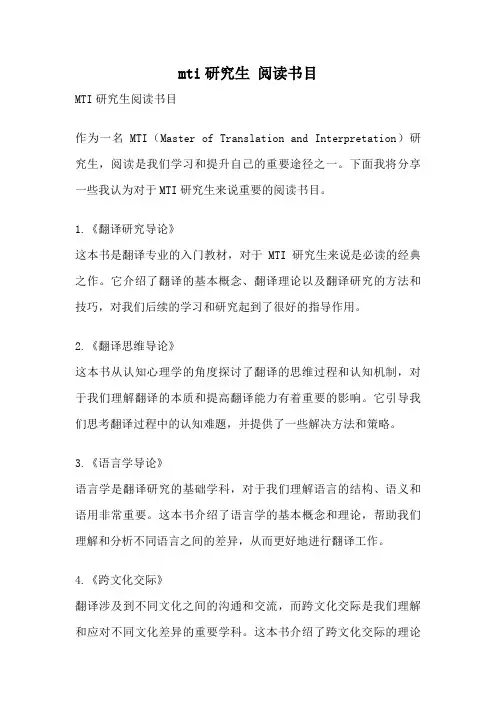
mti研究生阅读书目MTI研究生阅读书目作为一名MTI(Master of Translation and Interpretation)研究生,阅读是我们学习和提升自己的重要途径之一。
下面我将分享一些我认为对于MTI研究生来说重要的阅读书目。
1.《翻译研究导论》这本书是翻译专业的入门教材,对于MTI研究生来说是必读的经典之作。
它介绍了翻译的基本概念、翻译理论以及翻译研究的方法和技巧,对我们后续的学习和研究起到了很好的指导作用。
2.《翻译思维导论》这本书从认知心理学的角度探讨了翻译的思维过程和认知机制,对于我们理解翻译的本质和提高翻译能力有着重要的影响。
它引导我们思考翻译过程中的认知难题,并提供了一些解决方法和策略。
3.《语言学导论》语言学是翻译研究的基础学科,对于我们理解语言的结构、语义和语用非常重要。
这本书介绍了语言学的基本概念和理论,帮助我们理解和分析不同语言之间的差异,从而更好地进行翻译工作。
4.《跨文化交际》翻译涉及到不同文化之间的沟通和交流,而跨文化交际是我们理解和应对不同文化差异的重要学科。
这本书介绍了跨文化交际的理论和实践,帮助我们更好地理解和应对不同文化背景下的翻译问题。
5.《翻译研究方法与实践》这本书介绍了翻译研究的方法和实践技巧,对于我们进行研究论文的撰写和学术研究有着重要的指导作用。
它介绍了翻译研究的方法论、数据收集和分析的技巧,帮助我们进行科学的研究工作。
6.《专业翻译教程》这本书是一本实用性很强的教材,它介绍了不同领域的专业翻译技巧和实践经验。
对于我们进行专业领域翻译的学习和实践有着很大的帮助,提高我们的专业素养和翻译质量。
7.《口译技巧与实践》作为MTI研究生,口译是我们的一项重要技能。
这本书介绍了口译的技巧和实践经验,包括听力训练、记笔记、口译转换等方面的内容,对于提高我们的口译能力非常有帮助。
8.《笔译技巧与实践》除了口译,笔译也是我们的核心技能之一。
这本书介绍了笔译的技巧和实践经验,包括词汇选择、语言风格、文化背景等方面的内容,对于提高我们的笔译能力非常有帮助。

第一章翻译学的主要方面小结:翻译研究是一个相对较新的研究领域,近年来获得了迅猛发展。
翻译以前是作为语言学习的一种方法,或是比较文学、翻译工作坊和对比语言学课程的一部分。
这门新的学科在很大程度上应该归功于詹姆斯.霍姆斯,他在《翻译研究的名与实》一文中不但为该领域提供了一个名称,而且还规划了该学科的结构。
翻译理论研究、描述性翻译研究和应用翻译学是互相关联的,近年来都有发展,逐渐在翻译理论与翻译实践之间架起了一座桥梁。
3. James S. Holmes的《翻译研究的名与实》(The name and nature of translation studies, 1988年才为人所知)被认为是翻译学的“成立宣言”5. 俄裔美国结构主义学家Roman Jakobson在《论翻译的语言学方面》提出三种翻译类型:语内翻译(intralingual),语际翻译(interlingual),符际翻译(intersemiotic)6. 翻译研究作为一个学术研究领域是最近50年的事,它被称为“翻译学translatology”多亏了James S. Holmes.8. 18世纪晚期到20世纪60年代,语法-翻译教学法统治了中学语言学习(死记硬背外语的语法规则和结构),20世纪六七十年代,直接法或交际法兴起,语言学习摒弃对翻译的摒弃,翻译局限于高层次大学语言课程和专业译员培训。
第二章20世纪前的翻译理论小结:从西塞罗至20世纪的翻译理论大多围绕着翻译是该直译(“字对字”)还是意译(“意对意”)这一对矛盾进行,这是一个反复出现又毫无结果的争论,圣哲罗姆在用拉丁文翻译《圣经》时曾对这一对矛盾进行过著名的探讨。
有关《圣经》及其他宗教文本翻译的争论一千余年来一直在翻译理论中占据着中心地位。
早期的翻译理论家们大多在译著序言中为自己采用的翻译方法进行辩护,他们常常很少关注(或者根本无法获得)前人相关的著述。
德莱顿在17世纪末提出的三种翻译方法标志着更系统、更精确地研究翻译的开始,而施莱尔马赫对异质文本的尊重则对当代的学者产生了重大的影响。
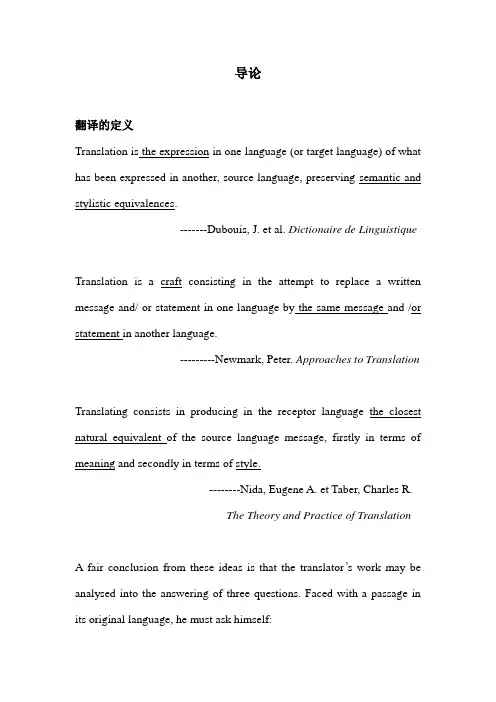
导论翻译的定义Translation is the expression in one language (or target language) of what has been expressed in another, source language, preserving semantic and stylistic equivalences.-------Dubouis, J. et al. Dictionaire de LinguistiqueTranslation is a craft consisting in the attempt to replace a written message and/ or statement in one language by the same message and /or statement in another language.---------Newmark, Peter. Approaches to TranslationTranslating consists in producing in the receptor language the closest natural equivalent of the source language message, firstly in terms of meaning and secondly in terms of style.--------Nida, Eugene A. et Taber, Charles R.The Theory and Practice of TranslationA fair conclusion from these ideas is that the translator’s work may be analysed into the answering of three questions. Faced with a passage in its original language, he must ask himself:(i) What does the author say?(ii) What does he mean?(iii) How does he say it?This method of analysis may be applied to the paragraph, to the sentence, or even to the phrase.-----Savory, Theodore. The Art of TranslationPassage translation:The word “winner”and “loser”have many meanings. When we refer to a person as a winner, we do not mean one who makes someone else lose. To us, a winner is one who responds authentically by being credible, trustworthy, responsive, and genuine, both as an individual and as a member of a society.单词“胜者”与“败者”含义颇多。
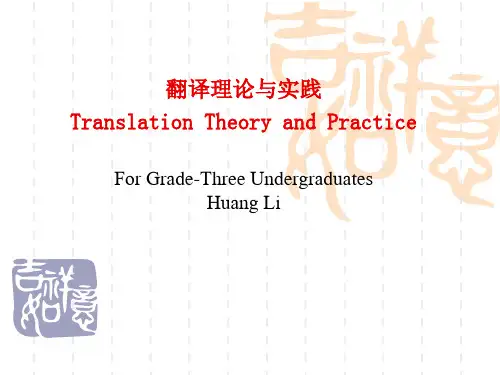
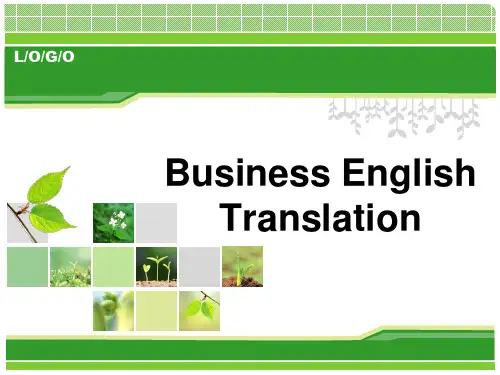
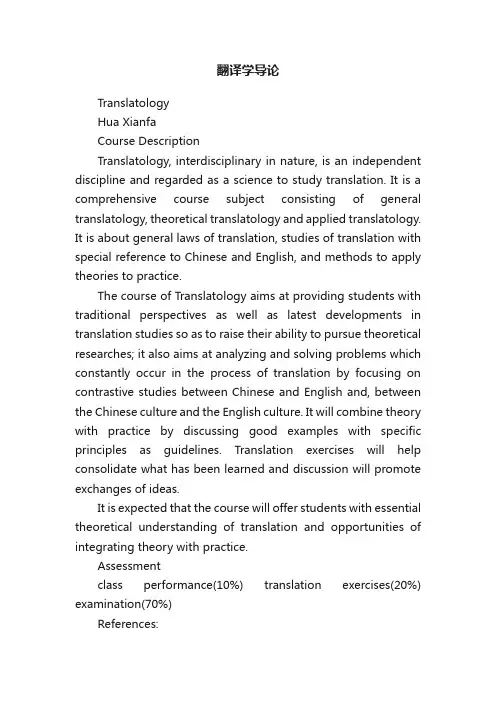
翻译学导论TranslatologyHua XianfaCourse DescriptionTranslatology, interdisciplinary in nature, is an independent discipline and regarded as a science to study translation. It is a comprehensive course subject consisting of general translatology, theoretical translatology and applied translatology. It is about general laws of translation, studies of translation with special reference to Chinese and English, and methods to apply theories to practice.The course of Translatology aims at providing students with traditional perspectives as well as latest developments in translation studies so as to raise their ability to pursue theoretical researches; it also aims at analyzing and solving problems which constantly occur in the process of translation by focusing on contrastive studies between Chinese and English and, between the Chinese culture and the English culture. It will combine theory with practice by discussing good examples with specific principles as guidelines. Translation exercises will help consolidate what has been learned and discussion will promote exchanges of ideas.It is expected that the course will offer students with essential theoretical understanding of translation and opportunities of integrating theory with practice.Assessmentclass performance(10%) translation exercises(20%) examination(70%)References:[1]Baker, Mona. In Other Words: A Coursebook on Translation[M]. London and New York:Routledge, 1992.[2]Baker, Mona. The Routledge Encyclopedia of Translation Studies[Z], London and New York:Routledge, 1997.[3]Chan, Tak-hung. Twentieth-Century Chinese Translation Theory: Modes, issues anddebates[M], Benjamins Translation Library, 2004.[4]House, J. Translation Quality Assessment: A Model Revisited[M], Tübingen: Niemeyer, 1997.[5]Munday, Jeremy. Introducing Translation Studies[M]. London: Routledge, 2001.[6]Newmark, P. A. Textbook of Translation[M]. London: Prentice Hall International(UK)Ltd. 1988[7]Newmark, P.A. Approaches to Translation[M]. London: Prentice Hall International(UK)Ltd.1988.[8]Nida, E.A. Language, Culture and Translating[M]. Shanghai: Shanghai ForeignLanguage Education Press, 1993.[9]Snell-Hornby, Mary. Translation Studies: An Integrated Approach[M]. ShanghaiForeign Language Education Press, 2001.[10]陈宏薇、李亚丹.新编汉英翻译教程[Z],上海:上海外语教育出版社,2004.[11]郭延礼. 中国近代翻译文学概论[Z], 武汉:湖北教育出版社,1998.[12]华先发、邵毅.新编大学英译汉教程[Z],上海:上海外语教育出版社,2004.[13]李定坤. 汉英辞格对比与翻译[Z],武汉:华中师范大学出版社,1994.[14]李瑞华. 英汉语言文化对比研究[C],上海:上海外语教育出版社,1997.[15]谭载喜. 翻译学[M], 武汉:湖北教育出版社,2000.[16]许均. 翻译论[M],武汉:湖北教育出版社,2003.Chapter I General TranslatologyGeneral translatology addresses the description of the phenomena of translation by focusing on such issues as the definition of translation, the nature of translation, types of translation, criteria of translation, procedures of translation, and disciplines related to translation and studies.1.1 What is translation?Different perspectives on the nature of translatingTranslation can be defined from different perspectives, which present to us different definitions:A. From the perspective of the process of the action itself:In the light of popular orientation (in dictionaries and encyclopedias), translation is to express (sth spoken or esp written) in another language or in simple words. (Hornby, A.S. OALECD 4th ed. 2000)Eugene Nida: Translating consists in reproducing in the receptor language the closest natural equivalent of the source language message, first in terms of meaning and secondly in terms of style. (1969:12)John Catford: Translation may be defined as follows: The replacement of textual material in one language (SL) by equivalent textual material in another language (TL). (1965:20) The central problem of translation practice is that of finding TLtranslation equivalents. A central task of translation theory is that of defining that nature and conditions of translation equivalence. (1965:21)Bahudarov: Translation is a process in which the parole of one language is transferred into the parole of another with the content i.e. meaning unchanged.Peter Newmark: Translation what is translation? Often, though not by any means always, it is rendering the meaning of a text into another language in the way that the author intended the text. (1988:5)B. From the perspective of the function of translation:Steiner: Translation it is that openeth the window, to let in the light; that breaketh the shell, that we may eat the kernel.Peter Newmark:Translation is an instrument of education as well as of truth precisely because it has to reach readers whose cultural and educational level is different from, and often “lower” or earlier, than that of the reader of the original. (1988:6) Peter Newmark: Translation has its own excitement, its own interest. A satisfactory translation is always possible, but a good translator is never satisfied with it. It can usually be improved. There is no such thing as a perfect ideal or …correct? translation.C.From the perspective of aesthetics:Malcolm Cowley: Translation is an art that involves the recreation of a work in another language for readers with a different background.D. From the perspective of the nature of translation:Peter Newmark: Translation is first a science, which entails the knowledge and verification of the facts and the language that describes them—here, what is wrong, mistaken or truth, can be identified; secondly, it is a skill, which calls for appropriatelanguage and acceptable usage; thirdly, an art, which distinguishes good from undistinguished writing and is the creative, the intuitive, sometimes the inspired, level of the translation; lastly, a matter of taste, where argument ceases, preferences are expressed, and the variety of meritorious translations is the reflection of individual differences. (1988:6)E. From the perspective of cross-cultural communicationJin Di & Nida: Translation is simply a form of interlingual communication.(1987)1.2 Types of translationTranslation can also be classified from different angles by different people.A. From the standpoint of signs involved in translation:Roman Jacobson: interlingual translation, intralingual translation, intersemiotic translation (interpretation of verbal signs by means of none verbal signs ) (On Linguistic Aspects of Translation)B. From the standpoint of way in which translation is carried out:Written interlingual translationOral interlingual transltionMachine translationC. From the standpoint of the extent to which translation is done:Full translation(absolute translation), partial translation (selective translation) , translation plus editing(translation with reconstruction)D. From the standpoint of the level of translationtotal translation (translation equivalence can be established at the same grammatical or phonological hierarchy)restricted translation (translation equivalence can be established at only one grammatical hierarchy)E. From the standpoint of the languages involved in translationtranslation from the native language into the foreign language or vice versa1.3 Criteria of translationAlexander F. TytlerA translation should give a complete transcript of the ideas of the original work; the style and manner of writing should be of the same character as that of the original; a translation should have all the ease of the original composition. (Tytler, 1797, P.15) John CatfordThe SL and TL rarely have …the same meaning? in the linguistic sense; but they can function in the same situation.For translation equivalence to occur, then both SL and TL texts must be relatable to the functionally relevant features of the situation.FedorovThe exactness of translation means the exact rendering of the thought and content of the original and performs the same rhetorical function as the original.Nidafunctional equivalenceThe crucial problem of translation is often stated in terms of conflict between formal correspondence and functional equivalence.A close formal correspondence in a receptor language so frequently does not carry the correct meaning of the source text. In some cases, formal correspondence doesn?t work , thenfunctional equivalence should take its place.There are five cases in which formal correspondence should be given up:1)When a literal rendering would give an entirely wrong meaning.2)When a borrowed term constitutes a semantic …zero? and is therefore likely to be filled with the wrong meaning.3)When a formal correspondence involves a serous obscurity in meaning.4)When formal correspondence would result in bad grammar or style in the receptor language.(Waard, Han, De & E.A. Nida)SavoryDifferent languages have different ways for expression, but all of them have an underlying equivalent thought.The translator faces the question as to whether his function is to record the words of the original or to report on their meanings.Gregory RabassaSo our criterion must state that the best translation is the closest approach.A translation can never equal the original; it can approach it, and its quality can only be judged by how close it gets.There are no two snowflakes alike.Yan Fufaithfulness, expressiveness and eleganceQian Zhongshusublimation the transmigration of souls “Although the body changes, the s oul of gesture remains its old self.”Fu LeiAs far as the effect is concerned, translation should be like copying a painting. What is desired is not being alike in appearance but being alike in spirit.Lu XunThe minimum requirement for general translation should at least convey faithfully the content of the original with understandable smooth translation, but this is not enough for literary translation… In literary translation, the artistic conception of the original is transmitted in another language so that when he is reading the translation, the reader can be inspired, touched and aesthetically affected the same as the if he were reading the original.Liu Zhongdefaithfulness, expressiveness and closeness1.4 Translation strategies and techniquesA. Translation strategiesChinese: 文and 质literal translation:word for word and line for line; keeping both the form and the content liberal/free translation: scarifying the form while keeping the content and spirit Schleiermacher: alienating and naturalizationEither the translator leaves the writer alone as much as possible and moves the reader toward the writer, or he [sic] leaves the reader alone as much as possible and moves the writer toward the reader. (Schleiermacher 1813/1992:41-42) Venuti: domestication and foreignizationDomestication: Domestication covers adherence to domestic literary canons by carefully selecting the texts that are likely to lend themselves to such a translation strategy(Venuti,1997:241) Foreignization: Foreignization entails choosing a foreign text anddeveloping a translation method along lines which are excluded by dominant cultural values in the target language.(Venuti, 1997:242)John Dryden: metaphrase, paraphrase and imitationB. Translation techniquestransliteration, annotation, paraphrase, amplification, omission, shift of perspective, adaptation,division, combination, specification, and generalization (华先发、邵毅,2004)1.5 The basic procedures of translationThe basic procedures of translation employed in translating consist of preparation, working and testing. Preparation refers to such matters as choosing what to be translated and contacting the publisher. Working includes both comprehension and expression. And testing is the final step taken to check the result of the work.1.5.1 Comprehension consists essentially in determining the meaning of the source language tex t, but …meaning? is to be interprete d in the broad sense of lexical, syntactic and rhetorical significance. It involves such steps as grammatical analysis, semantic analysis, stylistic analysis and discourse analysis. In other words, both form and content must be considered in comprehension.A. ComprehensionBe careful in determining the meaning of the words, phrases and sentences.(1)月明星稀,乌鹊南飞(曹孟德)(2) 若崩厥角稽首(孟子尽心下)(3) Mrs. Malaprop said, ”As she grew up, I would have her instructed in Geometry, that she might know something of thecontagious countries.” (R.B.Sheridan: The Rivals) (geometry[几何学]=geography[地理学]; contagious[传染的]=contiguous[邻近的])(4) “We sometimes fall in with persons who have seen much of the world, and of the men who, in their day, have played a conspicuous part in it, but who generalize nothing, and have no observation, in the true sense of the word.” (J. H. Newman)(5)王先生昨天被偷了。
- 238 -校园英语 / 【摘要】杰里米•芒迪的Introducing Translation Studies: Theories and Applications一书的中文译本《翻译学导论——理论与实践》由数位教授、博士合译,商务印书馆出版。
该译本对翻译理论的学习者不无帮助,但在具体的词语层面上存在不妥之处。
本文指出其中一些翻译问题,旨在引起译者们对同类问题的重视。
【关键词】《翻译学导论》 翻译问题一、引言杰里米•芒迪教授的Introducing Translation Studies: Theories and Applications 一书出版于2001年,按时间顺序介绍了自古罗马时期以来的主要翻译理论,每一章末尾有一个运用该章理论的翻译案例。
2010年上海外语教育出版社将其原文引进,书名译为《翻译研究入门:理论与应用》。
而早在2007年,商务印书馆已出版了其中文译本《翻译学导论——理论与实践》,旨在让中国读者了解西方翻译理论发展进程。
在封底上有这样的文字:“本书各章均由任教于各高等院校的翻译学教授及博士译成,译文准确忠实,并照顾到中文读者的研习需要,适量保留外文原文,俾便查考。
”“文本是翻译研究的对象与翻译批评活动中的价值客体”,赖斯也认为,译者在翻译过程中应依据原文的文本类型来选择相应的翻译策略,并建议将文本分类方法运用于翻译批评。
按照赖斯的理论,原文为以内容为重的文本,内容大于形式,因此准确地传达原文内容成为翻译的主要任务,准确地翻译术语更是重中之重。
笔者经仔细研读,认为译文的文本类型、目的与原文一致,然而难免在微观层面上有疏忽。
译文有的地方未能做到准确传达原文信息,难以称得上“准确忠实”。
王程辉认为,“可商榷的翻译各有各的误区,大致有三类:第一是译者功力,第二是常识逻辑,第三是各方合译。
”就本书而言,译者功力毋庸置疑,主要的问题存在于常识逻辑及各方合译,若将上述问题解决,译文将更加完善。
The practice of translating is long established, but the discipline of translation studies is new.1. The concept of translationTranslation:the general subject field;the product: the text that has been translatedthe process: the act of producing the translation, or translatingThe process of translation (or translating) involves the translator changing an original written text or the source text (ST) in the original verbal language or the source language(SL) into a written text or the target text (TT) in a different verbal language or the target language (TL).→‘interlingual translation’.Jakobson’s (1959) categories of translation:1. intralingual translation, or ‘rewording’: ‘an interpretation of verbal signs by means of othersigns of the same language’;2. interlingual translation, or ‘translation proper’: ‘an interpretation of verbal signs by means ofsome other language’;3. intersemiotic translation, or ‘transmutation’: ‘an interpretation of verbal signs by means of signsof non-verbal sign systems’).2 What is translation studies?James S. Holmes (“The Name and Nature of Translation Studies”, 1972): Translation Studies is concerned with ‘the complex of problems clustered round the phenomenon of translating and translations’ (Holmes 1988/2000: 173).Mary Snell-Hornby (Translation Studies: An Integrated Approach, 1988): ‘the demand that translation studies should be viewed as an independent discipline . . . has come from several quarters in recent years’.Snell-Hornby (1995): ‘the breathtaking development of translation studies as an independent discipline’ and the ‘prolific international discussion’ on the subject.Mona Baker (The Routledge Encyclopedia of Translation, 1997): ‘exciting new discipline, perhaps the discipline of the 1990s’Two ways translation studies has become more prominent:1) A proliferation of specialized translating and interpreting courses at both undergraduate and postgraduate level.In the UK in the 1960s: the first specialized university postgraduate courses in interpreting and translating established.In the UK in the academic year 1999/2000: at least 20 postgraduate translation courses and several designated ‘Centres of Translation’.250 university-level bodies in over 60 countries offering four-year undergraduate degrees and/or postgraduate courses in translation, training professional commercial translators and interpreters. (Caminade & Pym, 1995)2) Courses focusing on the practice of literary translation:In the UK: (1) Middlesex University; (2) the University of East Anglia (Norwich) (which houses the British Centre for Literary Translation).In Europe: a network of centres where literary translation is studied, practised and promoted, including Norwich, Amsterdam (the Netherlands), Arles (France), Bratislava (Slovakia), Dublin(Ireland), Rhodes (Greece), Sineffe (Belgium), Strälen (Germany), Tarazona (Spain) and Visby (Sweden).The 1990s also saw a proliferation of conferences, books and journals on translation in many languages.Long-standing international translation studies journals:Babel (the Netherlands)Meta (Canada)Across Languages and Cultures (Hungary)Literature in Translation (UK)Perspectives: Studies in Translatology (Denmark)Target (Israel/Belgium)The Translator (UK)Parallèles (Switzerland) and Traduire (France)Cadernos de Tradução (Brazil)Rivista Internazionale di Tecnica della Traduzione (Italy)Turjuman (Morocco)The main European publishers publishing books in translation studies:John BenjaminsMultilingual MattersRodopiRoutledgeSt JeromeProfessional publications dedicated to the practice of translation in the UKThe Linguist of the Institute of LinguistsThe ITI Bulletin of the Institute for Translating and InterpretingIn Other Words, the literary-oriented publication of the Translators’ AssociationTRANSST (Israel)BET (Spain)Key themes of international translation conferences (1999–2000):• translation and training translators (Bratislava, Slovakia);• literary translation (Mons, Belgium);• research models in translation studies (UMIST, Manchester, UK);• gender and translation (Norwich, UK);• translation as/at the crossroads of culture (Lisbon, Portugal);• translation and globalization (Tangiers, Morocco);• legal translation (Geneva, Switzerland);• translation and meaning (Maastricht, the Netherlands and Lodz, Poland);• the history of translation (Leon, Spain);• transadaptation and pedagogical challenges (Turku, Finland);• translation-focused comparative literature (Pretoria, South Africa and Salvador, Brazil).From being a little-established field a relatively short time ago, translation studies has now become one of the most active and dynamic new areas of research encompassing an exciting mix of approaches.3 A brief history of the disciplineWritings on the subject of translating go far back in recorded history.Cicero and Horace (first century BCE) and St Jerome (fourth century CE)The Greek Septuagint BibleStudy of translation developed into an academic discipline only in the second half of the 20th century.The grammar-translation method fell into increasing disrepute with the rise of the direct method or communicative approach to English language teaching in the 1960s and 1970s.▲Translation workshopIn the US, translation was promoted in universities in the 1960s by the translation workshop concept. The translation workshops were first established in the universities of Iowa and Princeton with the intention of introducing new translations into the target culture and for the discussion of the finer principles of the translation process and of understanding a text.▲Comparative literatureIn comparative literature, literature is studied and compared transnationally and transculturally, necessitating the reading of some literature in translation. This would later link into the growth of courses of the cultural studies type.▲Contrastive analysisContrastive analysis is the study of two languages in contrast in an attempt to identify general and specific differences between them. It developed into a systematic area of research in the USA from the 1930s onwards and came to the fore in the 1960s and 1970s. The contrastive approach heavily influenced other studies, such as Vinay and Darbelnet’s (1958) and Catford’s (1965), which overtly stated their aim of assisting translation research. However, contrastive analysis does not incorporate sociocultural and pragmatic factors, nor the role of translation as a communicative act.Nevertheless, the continued application of a linguistic approach in general, and specific linguistic models such as generative grammar or functional grammar, has demonstrated an inherent and gut link with translation.The evolving field of translation studies can point to its own systematic models that have incorporated other linguistic models and developed them for its own purposes.The construction of the new discipline does not consider translation as primarily connected to language teaching and learning, but as the specific study of what happens in and around translating and translation.The more systematic approach to the study of translation began in the 1950s and 1960s:• Jean-Paul Vinay and Jean Darbelnet’s contrastive approach(1958): categorizing what they saw happening in the practice of translation between French and English;• Alfred Malblanc (1963) did the same for translation between French and German;• Georges Mounin(1963): examining linguistic issues of translation;• Eugene Nida (1964): incorporating elements of Chomsky’s generative grammar as a theoretical underpinning of his books.The word ‘science’ was used by Nida in Toward a Science of Translating (1964).The German equivalent, ‘Übersetzungswissenschaft’, was taken up by Wolfram Wilss, Koller and the Leipzig school (where Kade and Neubert became active).James S. Holmes’s ‘The name and nature of translation studies’ is considered to be the ‘founding statement’ of a new discipline.1. The Holmes/Toury ‘map’A seminal paper in the development of the field as a distinct discipline was James S. Holmes’s (1972) ‘The name and nature of translation studies’. Gentzler describes it as ‘generally accepted as the founding statement for the field’ (1993: 92).Figure 1.1Two objectives of the ‘pure’ areas of research:1. The description of the phenomena of translation (descriptive translation theory);2. The establishment of general principles to explain and predict such phenomena (translationtheory). (Holmes 1988b/2000: 176–81)The ‘theoretical’ branch is divided into general and partial theories:‘General’ theoretical studies: describing or accounting for every type of translation and making generalizations that will be relevant for translation as a whole.‘Partial’ theoretical studies: (to be discussed below).Three possible foci of descriptive translation studies (DTS): examination of (1) the product, (2) the function and (3) the process:1. Product-oriented DTS examines existing translations, including the description or analysis ofa single ST–TT pair or a comparative analysis of several TTs of the same ST (into one or moreTLs). These smaller-scale studies can build up into a larger body of translation analysis looking at a specific period, language or text/discourse type. Larger-scale studies can be either diachronic (following development over time) or synchronic (at a single point or period in time). ‘One of the eventual goals of product-oriented DTS might possibly be a general history of translations – however ambitious such a goal might sound at this time’. (Holmes, 1988/2000: 177)2. Function-oriented DTS refers to the description of the ‘function [of translations] in therecipient sociocultural situation: it is a study of contexts rather than texts’ (Holmes, 1988/2000: 177). Issues that may be researched include which books were translated when and where, and what influences they exerted. This area (then termed ‘socio-translation studies’, but now called cultural-studies-oriented translation) was less researched at that time, but is more popular in current work on translation studies.3. Process-oriented DTS is concerned with the psychology of translation, trying to find out whathappens in the mind of a translator, but has still not yet been systematically analyzed.The results of DTS research can be fed into the theoretical branch to evolve either a general theory of translation or partial theories of translation ‘restricted’ according to the following subdivisions:• Medium-restricted theories: subdividing according to translation by machine and humans, with further subdivisions according to whether the machine/computer is working alone or as an aid to the human translator, to whether the human translation is written or spoken and to whether spoken translation (interpreting) is consecutive or simultaneous.• Area-restricted theories:restricted to specific languages or groups of languages and/or cultures. It is closely related to work in contrastive linguistics and stylistics.• Rank-restricted theories: restricted to a specific level of the word or sentence or text.• Text-type restricted theories:related to specific discourse types or genres, such as literary, business and technical translation. Text-type approaches came to prominence with the work of Reiss and Vermeer in the 1970s.• Time-restricted: referring to theories and translations limited according to specific time frames and periods (i.e. the history of translation).• Problem-restricted theories: referring to specific problems (such as equivalence) or whether universals of translated language exist.Several different restrictions can apply at any one time. For example, the study of the translation of novels would be area restricted, text-type restricted and time restricted.The ‘applied’ branch of Holmes’s framework concerns:• translator training: teaching methods, testing techniques, curriculum design;• translation aids: such as dictionaries, grammars and information technology;• translation criticism: the evaluation of translations, including the marking of student translations and the reviews of published translations.Translation policy: the translation scholar advise on the place of translation in society, including what place, if any, it should occupy in the language teaching and learning curriculum.Figure 1.2The applied branch of translation studies‘Applied’Translator training Translation aids Translation criticismteaching testing curriculum revision reviewsevaluation techniques designmethods evaluationof translationsIT applications dictionaries grammarstranslation on-line use ofsoftware databases internetThe merit of Holmes’s divisions: they allow a clarification and a division of labour between the various areas of translation studies which, in the past, have often been confused (Toury, 1995: 9)The crucial role of Holmes’s paper: delineating the potential of translation studies.‘Translation policy’ would nowadays far more likely be related to the ideology that determines translation than was the case in Holmes’s description.The restrictions of Holmes’s divisions:1) A discourse-type and a text-type restriction2) Inclusion of interpreting as a sub-category of human translation3) Omission of any mention of the individuality of the style, decision-making processes andworking practices of human translators involved in the translation process (Pym, 1998: 4)2.Developments since the 1970sThe surge in translation studies since the 1970s has seen different areas of Holmes’s map come to the fore.◆Contrastive analysis has fallen by the wayside.◆The linguistic-oriented ‘science’ of translation has continued strongly in Germany, but theconcept of equivalence associated with it has declined.◆Germany has seen the rise of theories centred around text types (Reiss) and text purpose (theskopos theory of Reiss and Vermeer).◆The Hallidayan influence of discourse analysis and systemic functional grammar has beenprominent over the past decades, especially in Australia and the UK, and has been applied to translation in works by Bell (1991), Baker (1992) and Hatim and Mason (1990, 1997).◆The descriptive approach (originating in comparative literature and Russian Formalism) rose inthe late 1970s and the 1980s.◆In Tel Aviv, Itamar Even-Zohar and Gideon Toury have pursued the idea of the literarypolysystem in which different literatures and genres, including translated and non-translated works, compete for dominance.◆The polysystemists have worked with a Belgium-based group (including José Lambert and thelate André Lefevere), and with the UK-based scholars Susan Bassnett and Theo Hermans.◆The Manipulation of Literature: Studies in Literary Translation (Hermans, 1985) gave rise tothe name of the ‘Manipulation School’ and held sway for much of the following decade.◆The 1990s saw the incorporation of new schools and concepts:●Canadian-based translation and gender research led by Sherry Simon;●The Brazilian cannibalist school promoted by Else Vieira;●Postcolonial translation theory, with the prominent figures of the Bengali scholarsTejaswini Niranjana and Gayatri Spivak;●In the USA, the cultural-studies-oriented analysis of Lawrence Venuti, who champions thecause of the translator.。
第一章For personal use only in study and research; not for commercial use第二章第三章翻译学的主要方面小结:翻译研究是一个相对较新的研究领域,近年来获得了迅猛发展。
翻译以前是作为语言学习的一种方法,或是比较文学、翻译工作坊和对比语言学课程的一部分。
这门新的学科在很大程度上应该归功于詹姆斯.霍姆斯,他在《翻译研究的名与实》一文中不但为该领域提供了一个名称,而且还规划了该学科的结构。
翻译理论研究、描述性翻译研究和应用翻译学是互相关联的,近年来都有发展,逐渐在翻译理论与翻译实践之间架起了一座桥梁。
1. 翻译实践历史悠久,翻译学却是一门新兴学科。
2. 翻译实践和翻译理论之间的割裂持续存在。
3. James S. Holmes的《翻译研究的名与实》(The name and nature of translation studies, 1988年才为人所知)被认为是翻译学的“成立宣言”4. 翻译可以指翻译研究领域、翻译产品(译本)或者翻译过程(产生译本的行为)5. 俄裔美国结构主义学家Roman Jakobson在《论翻译的语言学方面》提出三种翻译类型:语内翻译(intralingual),语际翻译(interlingual),符际翻译(intersemiotic)6. 翻译研究作为一个学术研究领域是最近50年的事,它被称为“翻译学translatology”多亏了James S. Holmes.7. 对翻译的探讨,从公元前1世纪的西塞罗、贺拉斯和公元4世纪的圣哲罗姆(《七十子希腊文本圣经》)就开始了,后者被翻译成拉丁文时所用的手法影响了其后的圣经翻译。
8. 18世纪晚期到20世纪60年代,语法-翻译教学法统治了中学语言学习(死记硬背外语的语法规则和结构),20世纪六七十年代,直接法或交际法兴起,语言学习摒弃对翻译的摒弃,翻译局限于高层次大学语言课程和专业译员培训。